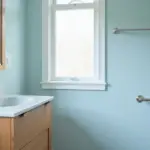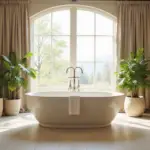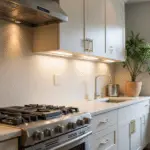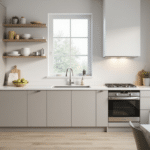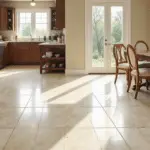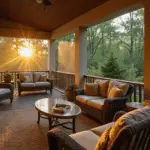Hey there, urban dwellers and design enthusiasts! Zara here, ready to dive into the colorful world of open-plan dining areas. You know, growing up in a cozy Oakland apartment taught me a thing or two about maximizing space. Now, as a designer, I’m all about creating harmony in our homes – and let me tell you, paint is our secret weapon!
Whether you’re working with a sprawling loft or a compact studio, the right splash of color can transform your dining space from ‘meh’ to ‘marvelous’. And the best part? It’s a sustainable way to refresh your home without breaking the bank or the planet. So, grab a chai (or your beverage of choice), and let’s explore how to use paint to create a dining area that’s as vibrant as your dinner conversations!
Need some dining room paint inspiration? I’ve got you covered. Let’s paint our way to perfection!

Key Takeaways
Before we roll up our sleeves and get painting, let’s brush up on some key points:
- Harmony is key – choose colors that sing together like a well-tuned orchestra.
- Get creative with techniques like accent walls or ombre effects to define your space without building walls.
- Set the mood – warm colors for cozy family dinners, cool tones for zen solo meals.
- Keep the flow going – your colors should transition as smoothly as a well-planned menu.
- Test before you invest – paint samples are like taste tests for your walls.
- Make it personal – your space should reflect you, just like your cooking reflects your taste!
Importance of Paint in Open Plans
Let’s chat about why paint is the MVP in open-plan spaces. Trust me, it’s not just about looking pretty (though that’s a delicious bonus!).
Define Spaces
Picture this: you’re hosting a dinner party, and your guests are mingling seamlessly between the living area and dining space. How? The magic of paint! By using contrasting colors, we can create invisible ‘walls’ that guide the flow of conversation and appetizers. It’s like creating a map without pulling out a single piece of paper!

Enhance Aesthetics
Now, let’s talk beauty. The right colors can make your space sing louder than a Bollywood musical! I always tell my clients to think of paint as the backdrop to their life’s story. Choose hues that complement your beloved heirloom furniture or that funky art piece you picked up at the flea market. It’s all about creating a space that feels uniquely you.
Maintain Openness
Here’s a little secret from my Oakland roots – light colors are your best friend in small spaces. They’re like a breath of fresh air, keeping your home feeling open and inviting. Dark colors have their place (we’ll get to that!), but use them wisely. Remember, we want a space that flows as smoothly as your favorite playlist.
Techniques for Defining Dining Areas
Alright, let’s get to the fun part – painting techniques that’ll make your dining area pop!

Accent Walls
You know that feeling when you bite into a perfectly spiced samosa? That’s what an accent wall does for your dining area – it adds that perfect punch of flavor! Pick a wall that naturally draws the eye, like the one behind your dining table. Go bold with a vibrant hue or get creative with a patterned wallpaper. Just remember to balance it out with neutral tones elsewhere, so your space doesn’t end up looking like a chaotic spice market (unless that’s your vibe, of course!).
Color Blocking
Color blocking is like the color wheel took a yoga class – it’s all about balance and harmony. Try pairing complementary colors for a look that’s modern and oh-so-chic. I once designed a space with deep indigo and soft marigold – it was like bringing a piece of India’s colorful streets right into a San Francisco apartment!
Visual Separation
Here’s where we get sneaky with our paint. Different colors can create ‘zones’ without any physical barriers. It’s like magic! Try using warm terracotta for your living area and a cool sage for the dining space. The transition should be as smooth as a well-executed yoga flow – no jarring moves here!

Choosing the Right Colors
Choosing colors is like picking ingredients for the perfect recipe – it’s all about balance and personal taste.
Harmonize with Surroundings
When I’m selecting colors, I always think about the whole space, not just the dining area. It’s like coordinating an outfit – everything should work together. Consider the colors in your adjacent rooms and choose hues that play well with others. This creates a sense of flow that’s as smooth as a perfectly poured latte.
Use Bold Colors Sparingly
Bold colors are like spices – a little goes a long way! I love using vibrant hues inspired by my Indian heritage, but I’m careful not to overwhelm the space. Try using bold colors for small accents or feature walls. It’s like adding a pinch of saffron to a dish – it brightens everything up without taking over.
Neutral Tones
Ah, neutrals – the perfect canvas for your creativity! Shades like warm beige, soft gray, or crisp white are the yoga pants of the color world – they go with everything and never go out of style. Plus, they create a calm backdrop that lets your decor shine. Pair them with natural textures like jute or bamboo for a look that’s as refreshing as a morning meditation session.

For those of you looking to create a modern dining room paint scheme, neutrals are your best friends. They provide the perfect backdrop for sleek, contemporary furniture and bold art pieces.
Creating Flow in Open Layouts
Creating flow in an open layout is like choreographing a dance – every move should lead seamlessly into the next.
Transitioning Colors
Think of color transitions like a beautiful ombre effect – gradual and natural. I love using this technique to blend spaces. It’s like the way the sky changes color at sunset – subtle and stunning. Try moving from a light sage in your kitchen to a deeper forest green in your dining area. It’s a visual journey that guides the eye and creates harmony.
Consistent Palette
Sticking to a consistent color palette is key in open layouts. It’s like creating a capsule wardrobe for your home – everything should mix and match effortlessly. Choose a main color and then play with different shades and tones throughout your space. This creates depth and interest while maintaining a cohesive look.

Focal Points
Every great space needs a star of the show! Use paint to create focal points that draw the eye and add character. It could be a boldly painted fireplace or a vibrant hutch showcasing your grandmother’s china. These focal points are like the garnish on a perfectly plated dish – they add that final touch of wow factor!
Practical Tips and Ideas
Now, let’s get down to the nitty-gritty with some practical advice to make your painting project a success!
Sample Color Schemes
Before you commit to a color, always, always sample! It’s like tasting your curry before serving – essential! Here are a couple of my favorite combinations:
- Earthy Spice Market: Combine warm terracotta with soft sage and creamy beige. It’s like bringing the colors of an Indian bazaar into your home.
- Urban Oasis: Pair cool gray with pops of vibrant teal and sunny yellow. It’s refreshing and energizing, perfect for city dwellers.

Remember, colors can look different depending on your lighting, so always test them in your actual space.
Paint Finishes
Choosing the right finish is as important as choosing the right color. Here’s a quick guide:
- Matte: Great for hiding imperfections, but less durable. Perfect for low-traffic areas.
- Satin: My go-to for dining areas. It’s durable and easy to clean, with a subtle sheen that adds depth.
- Gloss: Reflects light beautifully but shows every imperfection. Use sparingly for accents or in very dark rooms.
If you’re wondering about paint colors for wood furniture, remember that the finish of your paint can dramatically affect how it interacts with your furniture’s finish.
DIY vs Professional Help
Deciding whether to DIY or hire a pro is like choosing between cooking at home or eating out – both have their merits! If you’re comfortable with a roller and have the time, DIY can be a fun and budget-friendly option. But if the thought of taping edges makes you break out in a cold sweat, there’s no shame in calling in the pros. Sometimes, investing in expertise is worth every penny.
Final Remarks
Whew! We’ve covered a lot of ground, haven’t we? From defining spaces with bold accents to creating flow with subtle transitions, paint truly is the secret ingredient in the recipe for a fantastic open-plan dining area.

Remember, your home is a reflection of you – so don’t be afraid to let your personality shine through in your color choices. Whether you’re drawn to the warm, spicy hues of an Indian summer or the cool, calming tones of a Scandinavian fjord, there’s a palette out there that’s perfect for your space.
Now, it’s time for action! Grab those paint samples, start experimenting, and transform your dining area into a space that nourishes both body and soul. Trust me, there’s nothing quite like the satisfaction of sitting down to a meal in a room you’ve poured your creativity into.
And hey, if you need a little extra guidance or inspiration, I’m always here to help. Let’s create a space that’s as vibrant and unique as you are!
Green Tip of the Day: Opt for low-VOC or zero-VOC paints to minimize harmful emissions. It’s better for your health and the planet – a win-win in my book!
Happy painting, and bon appétit!
Frequently Asked Questions
What are the benefits of using paint in an open-plan dining area?
Oh, where do I start? Paint is like the fairy godmother of interior design – it can transform your space with a wave of a brush! It defines areas, sets the mood, and can even make your space feel larger. Plus, it’s a budget-friendly way to refresh your home without a full renovation. Win-win!

How can I define my dining area in an open-plan space?
Think of paint as your invisible architect. Use different colors or shades to create a visual boundary for your dining area. An accent wall behind your dining table can work wonders, or try using a slightly darker shade for your dining zone. It’s like drawing lines on the floor, but way more stylish!
What color schemes work best for open-plan dining areas?
It depends on your style and the mood you want to create. Neutrals like soft grays or warm beiges are always a safe bet – they’re like the perfect white shirt of interior design. For a bolder look, try deep blues or greens. They add sophistication without overwhelming the space. Just remember to consider the rest of your decor – you want everything to play nicely together!
How do I create a flow between my dining area and other spaces?
Think of your color scheme like a well-composed melody – everything should harmonize! Use complementary colors or different shades of the same color to create a cohesive look. You can also use decor elements like rugs or artwork to tie different areas together. The goal is to make the transition from one space to another as smooth as a perfectly executed dance move!
Are there specific paint finishes recommended for dining areas?
Absolutely! In my experience, satin or semi-gloss finishes are ideal for dining areas. They’re like the yoga pants of paint finishes – practical and good-looking! These finishes are durable and easy to clean (hello, spaghetti sauce splatters!), which is crucial for your eating space. Plus, they have a subtle sheen that adds a touch of elegance.

Can I mix different colors in an open-plan layout?
Of course! Mixing colors is like creating a perfectly balanced curry – it’s all about finding the right combination. Make sure your colors complement each other and maintain a cohesive overall look. Use the 60-30-10 rule: 60% dominant color, 30% secondary color, and 10% accent color. It’s a foolproof recipe for color success!
How often should I repaint my open-plan dining area?
Think of repainting like refreshing your wardrobe – it depends on wear and tear and your desire for change. Generally, every 5-7 years is a good rule of thumb. But hey, if you’re feeling adventurous or your walls look tired, there’s no harm in giving your space a new look sooner. After all, change is the spice of life!

